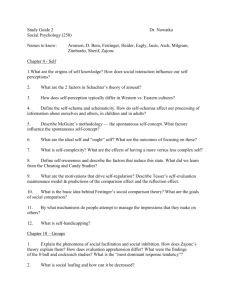Power
advertisement
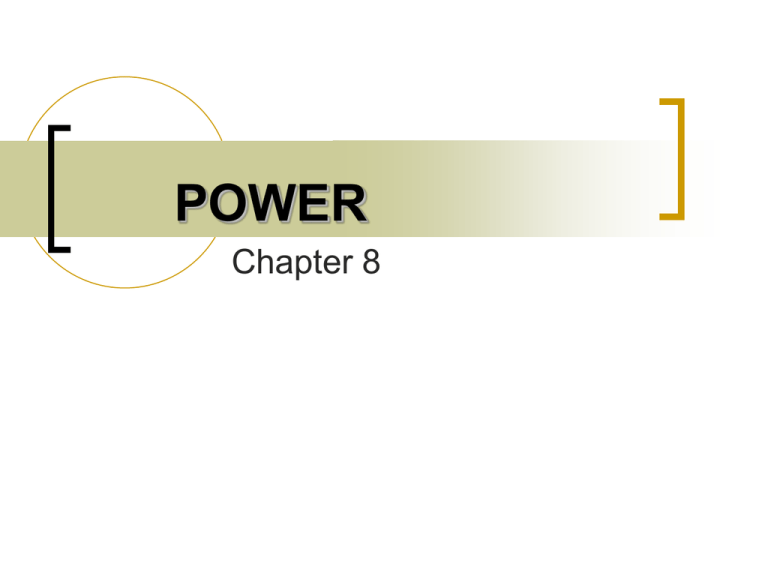
POWER Chapter 8 Power Can people be compelled to act in ways they would never consider acting? Power Over Group Members? Social power: the capacity to influence others Commonplace practice – coach demanding obedience from his/her athletes, a VP demanding that deadlines be met, board members and extraordinary effects of power Sometimes leads to disastrous outcomes Cults and other extreme forms of influence How To Be A Cult Leader ? Pratkanis and Aronson Create your own social reality. --isolation --create an ideology, a myth Create an ingroup, insiders (granfallon) Create commitment (through dissonance reduction) Enhance leader’s power Proselytize Thought control, overload, distraction Fix members on a goal Milgram’s Study of Obedience to Authority Basic paradigm Shock machine Basic condition: series of errors, pounding on the wall at 300 volts, refused to answer at 315 volts Prods: "The experiment requires that you continue" 300 volts: first 5 refuse 40 35 65% obey to the end 30 25 20 15 10 5 0 0 30 60 90 120 150 180 210 240 270 300 330 360 390 390 Number of Participants Remaining at Each Shock Level Results: 65% obedience 420 450 Percentage who obeyed to 450 volts 0 20 40 Baseline Voice-feedback Same room Touch Heart problem Bridgeport Obedient others Disobedient others Variations on the theme 60 80 Milgram’s Study (cont) Other findings Harm and proximity Prestige Expertise of authority Group effects Methodological and ethical criticisms Application: obedience and deference in flight crews Zimbardo's Stanford Prison Study (Haney, Banks, & Zimbardo, 1973). Results: study was aborted because situation overpowered the subjects Sources of Power in Groups French & Raven's Power Bases Theory Reward: control rewards given or offered Coercive: threaten or punish those who do not comply with requests or demands Legitimate: powerholder’s sanctioned right to require and demand obedience Sources of Power in Groups French & Raven's Power Bases Theory Referent: identification, respect, and attraction for the powerholder Expert: target’s beliefs that the powerholder possesses superior skills and abilities Informational: access to and control of information (factual/fictional) Sources of Power in Groups (cont) Applications Milgram’s experiment Bullying Weber’s concept of charismatic leadership Power Processes in Groups Superior-subordinate relations – acknowledgement of hierarchical positioning Interpersonal complimentary hypothesis Agentic state (lowered responsibility) Role demands: Zimbardo’s Stanford Prison study Behavioral commitment • Foot-in-the-door technique • Brainwashing The fundamental attribution error (FAE) & obedience Using Power to Influence Others Kelman’s three-stage model of conversion Compliance – group members comply with the powerholder’s demands, but they do not personally agree with them Identification – group members are motivated to please the authority Internalization – group member follow the orders of the powerholder b/c the orders are congruent with personal beliefs Using Power to Influence Others Resistance to influence Revolutionary coalitions Reactance Conflict and rebellion authority (the ripple effect) Power Tactics Power tactics: methods people use to get their way Direct (strong) vs. indirect (weak) tactics Rational (logic) vs. nonrational (emotional) Unilateral (enacted without cooperation) vs. Bilateral (more interactive) Effects of Power Approach-inhibition model of power Power leads to approach behavior (positive affect, automatic processing, action) Powerlessness leads to inhibition (negative affect, controlled processing, inaction) Corrupting Effects of Power Power and personality Power motivation: the need for power – more vigorously than others Social dominance orientation (SDO) – a dispositional tendency to accept and even prefer circumstances that sustain social inequalities – greater male preference Communal orientation vs. exchange orientation Corrupting Effects of Power (cont) Corrupting influence of power Mandate phenomenon – a tendency for leaders to overstep the bounds of their authority when they feel they have support from the group Changes in the perceptions of subordinates Reliance on power to influence others Michel’s iron law of oligarchy: any group where power is concentrated with few powerholders doing whatever possible protect and enhance their power Psychopathy Egocentric, deceitful, shallow, impulsive individuals who use and manipulate others Callous, lack of empathy Little remorse Thrill-seeking “human predators” (Hare, 1993) No “conscience” Psychopathy Checklist-Revised (Hare, 1991) Glib and superficial Egocentric and grandiose Lack of remorse or guilt Lack of empathy Deceitful and manipulative Shallow emotions Impulsive Poor behavior controls Need for excitement Lack of responsibility Early behavior problems Adult antisocial behavior
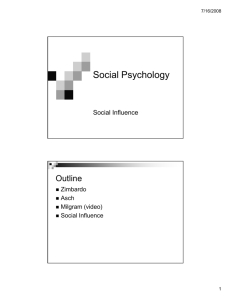
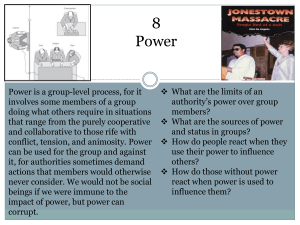
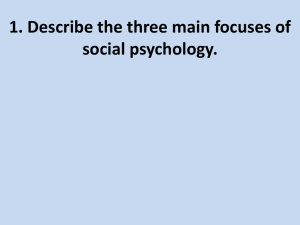
![milgram[1].](http://s2.studylib.net/store/data/005452941_1-ff2d7fd220b66c9ac44050e2aa493bc7-300x300.png)
